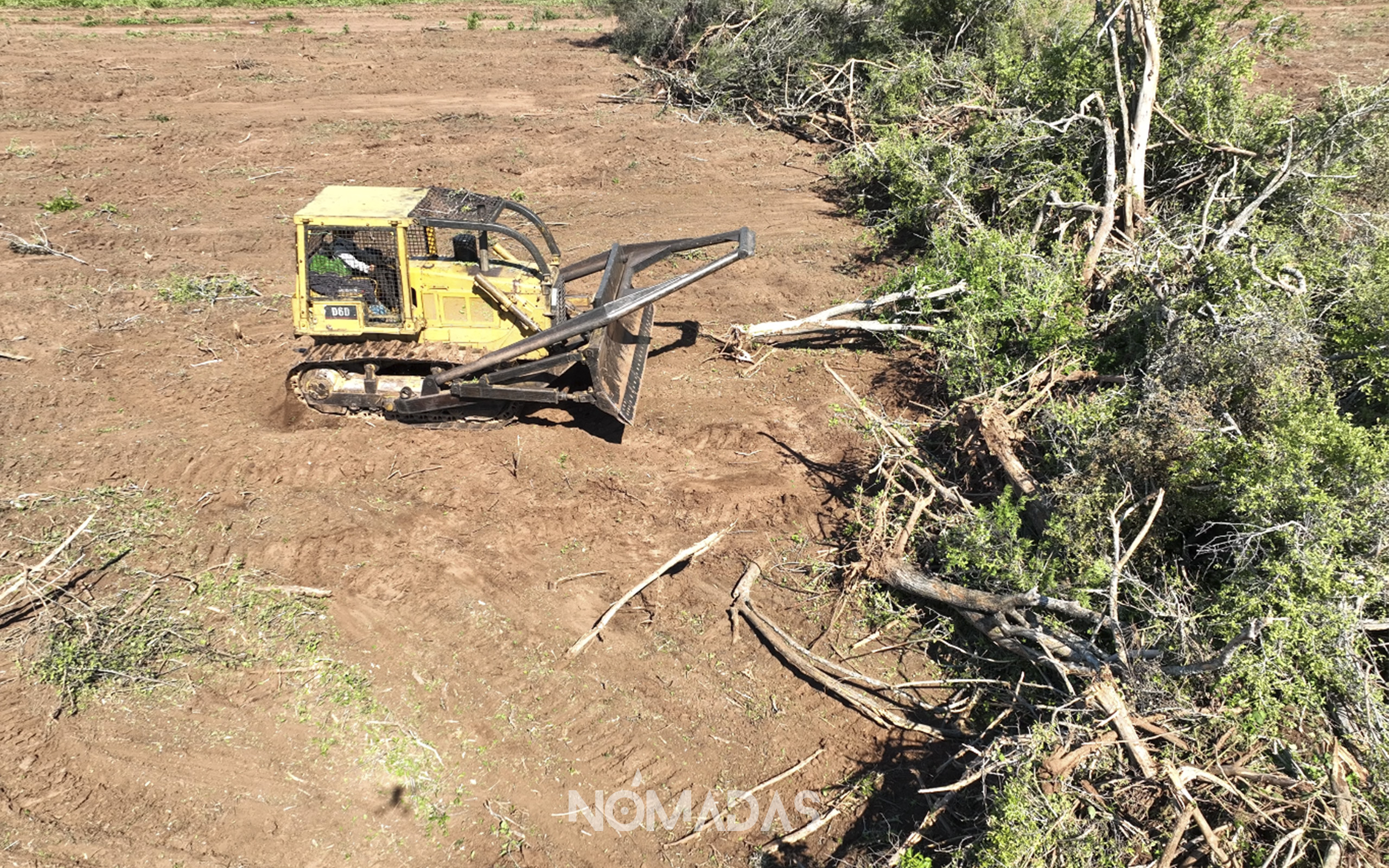ENGLISH


ENGLISH

Trees fall victim to the power of machinery and human appetite.
September 1st, 2023
Bolivia is the country with the highest per capita loss of primary forest worldwide. Its deforestation rate per person is four times higher than that of Brazil. The Global Forest Watch (GFW) platform reveals the harsh reality that the country’s forests and the world are facing.

Iván Paredes
Journalist
In Bolivia, indigenous communities no longer sleep peacefully. The noise of falling trees disrupts their tranquility. The sounds of tractor engines and chainsaws are almost normal sounds, especially in the Chiquitano forests, the Amazon, and the Chaco regions. All of this is a result of the brutal destruction of forests that Bolivia is experiencing, keeping the country in the sad global spotlight for the highest deforestation rates. It ranks as the third nation on the planet in terms of forest loss for the third consecutive year. In 2022, the country achieved a record deforestation figure: 32% more compared to the previous year, amounting to 385,567 hectares of primary humid forest and 595,996 hectares of tree cover.
The reasons for this forest destruction are numerous, but the main driver of this environmental catastrophe is agricultural expansion. Of the staggering figures, 41% of deforested areas are concentrated in five municipalities in the Santa Cruz department: San Ignacio de Velasco, Charagua, Pailón, Concepción, and San José de Chiquitos. These communities do not live their days in peace. In these areas, forests are disappearing at an alarming rate, right under the watchful eyes of authorities.
Among the main causes of this environmental catastrophe is agricultural expansion, with 41% of deforested areas concentrated in five municipalities in Santa Cruz.
The Global Forest Watch (GFW), supported by the World Resources Institute (WRI) and with forest data collected by the University of Maryland, revealed that in the year 2022, 4.1 million hectares of tropical rainforest were lost worldwide. Brazil leads this list, followed by the Democratic Republic of Congo, and Bolivia holds the third position, maintaining this rank for the third consecutive year. These are alarming statistics. In 2022 alone, an area of forest equivalent to the size of Switzerland was lost worldwide. Among these figures, Bolivia stands out among the most notorious. According to GFW, around 400,000 hectares were deforested in the South American country in the previous year. This unprecedented number stems from agricultural expansion.
GFW organized a virtual space to delve deeper into the situation facing Bolivian forests. The Friends of Nature Foundation (FAN) also participated in the event, contributing data to the discussion on this topic and proposing strategies to prevent Bolivian trees from falling like dominoes.
Mauricio Tomichá, president of the Territorial Base Organization (OTB) of Palmarito de la Frontera, in the Monte Verde Indigenous Territory in the Santa Cruz department, also participated in the meeting. The leader transported the audience to the warm lands of the Bolivian Chiquitania, highlighting the potential of these areas and presenting sustainable strategies for utilizing natural resources. Additionally, he made an appeal to halt deforestation.
Tomichá paints a majestic picture of the Palmarito de la Frontera community, a green space where deforestation seeks to enter ruthlessly. The indigenous leader reveals that the trees in his community are counted. This Chiquitano population obtained the green certification as a guarantee of their sustainable management of timber resources across a portion of their 16,500 hectares of land.
Palmarito de la Frontera is protected. It is a community teeming with vegetation, where wild animals have, for now, a well-preserved home. Tomichá is afraid. This fear arises from the fact that trees are being felled mercilessly, without pity, near his community. The leader does not want that to happen in his town, he does not want Bolivia’s green to be destroyed. He does not want Palmarito de la Frontera to become an island surrounded by deforested fields.
To understand the deforestation situation in Bolivia, Mikaela Weisse, the director of GFW, led a virtual session. The expert began her presentation with an explanation: The study clarifies that the loss of tree cover is not the same as deforestation. Tree cover can refer to trees in plantations as well as natural forests, while deforestation is the removal of tree cover due to human or natural causes, including fires. Tropical primary forests are areas of mature and natural tropical forest cover that have not been recently logged or regenerated.
Bolivia leads the world in primary forest loss per capita, with a rate four times higher than that of Brazil.
«For the third consecutive year, Bolivia surpasses Indonesia. Historically, Indonesia had much greater losses and held this third place, but now Bolivia holds the third place. Bolivia receives much less attention compared to other countries. In terms of forest loss per capita, Bolivia has the highest loss,» highlighted Weisse.
And the situation is just as alarming. Bolivia has the highest per capita loss of primary forest worldwide, despite having less than a quarter of the primary forest loss of Brazil. Its deforestation rate per capita is four times higher than that of its neighboring country.
In 2022, Bolivia lost 385,567 hectares of primary humid forest, marking the year with the highest recorded loss in the country. Additionally, it lost 595,996 hectares of tree cover in the same period. These figures are alarming. Weisse detailed that the most affected biomes in Bolivia are the Chiquitania, the Chaco, and the Amazon. Among these regions, the Chiquitania suffers the most from deforestation.
«70% of forest loss occurs in the Santa Cruz department. These are data we have from satellite images showing where the loss is occurring. We are limited in pinpointing the causes of deforestation, but there are ways we can observe, such as soybean cultivation and fires. 23% of forest loss caused by soybean cultivation in Bolivia was due to the expansion of Mennonite colonies,» Weisse explained.
In Bolivia, in recent years, the Forest and Land Social Control and Supervision Authority (ABT) issued thousands of fines for environmental and forest violations. In fact, during the last decade, 6,463 administrative processes were initiated nationwide, with 62% (4,003) corresponding to violations related to illegal logging and burning.
Despite the significant number of processes, Bolivian fines for deforestation are not effective, as they are the lowest in South America. Worse yet, historic violations from 1996 onwards have been forgiven. Adding to this, Bolivia is not part of the countries that joined the Glasgow Leaders’ Declaration in 2021. This agreement, signed by 130 countries at the 2021 United Nations Climate Change Conference, aims to halt and reverse deforestation by 2030. Brazil is also not part of this instrument.
It’s a slow suffering. The Bolivian forest, especially in the eastern part of the country, weeps, and few are trying to save it. Year after year, Bolivia appears on the blacklist of deforestation. In South America, it stands alongside Brazil as one of the countries with the highest rates of deforestation. The causes are difficult to define, but there is one that is primary: the advance of the agricultural frontier. In this eagerness to bring down the trees, livestock, colonization settled on lands, and the increased influx of Mennonites are all included.
From the sky, the Chiquitano forest has perfectly geometric lines. These are satellite images that show a green less vivid compared to the brown of the land where the people who deforested these fields will work. Every passing year, the images show more shades of brown and fewer of green. Thus, the trees fall. The green is disappearing from Bolivia’s face.
Despite the large number of administrative processes for environmental and forestry violations, fines for deforestation in Bolivia are low, and many historical infractions have been pardoned.
The green is in danger of extinction. Natalia Calderón is the director of the Friends of Nature Foundation (FAN). With firsthand knowledge, she explained that there are several factors behind the causes of deforestation, as well as underlying factors that contribute to forest loss. Calderón highlights two major causes that are the primary drivers of deforestation each year: the expansion of the agricultural sector and the increase in Mennonite colonies in Bolivia.
«Agricultural expansion is the main cause of deforestation, but care must be taken when identifying the actor. Automatically pointing to the agribusiness sector is too simplistic. They play a role, including medium and large properties, and it’s not easy to distinguish between soy, livestock, industry, or other types of crops. We need to make an effort, and we’re in the process of achieving greater precision. Roughly a third of deforestation and changes in land use are linked to these medium and large properties, which are not always easy to distinguish from agribusinesses created with foreign capital. It’s not just Bolivians; there’s a lot of Brazilian, Paraguayan, and Uruguayan investment coming into the country,» Calderón emphasized.
The director of FAN detailed that in 2022, the Forestry and Land Social Control Authority (ABT) authorized the clearance of 215,676 hectares across the country. This figure is 15% higher than in 2021. 56% of clearances were carried out on private lands, 35% in peasant communities, and 9% in indigenous communities. But the most alarming statistic is this: 52% of the deforestation that ravaged forests in 2022 was illegal. This statistic was confirmed by ABT in its accountability report for that period.
Mennonite colonies also play a role in the deforestation plan, primarily due to their cultivation of soy, which leads to forest clearance, especially in the Chiquitania and Chaco regions. Mennonites have been in Bolivia since 1954. Since then, their main settlements have been consolidated and spread throughout the expansion region of Santa Cruz, which concentrates over two-thirds of cultivated lands in Bolivia and is dominated by large-scale agro-industrial production for export.
Today, around 150,000 Mennonites inhabit Bolivia in at least 120 colonies, according to a study by William Kehler, a Mennonite who has been in the country for 30 years. According to a study conducted by researcher Alle Rechte in 2019, there were 106 colonies until that year.
After Bolivians and Brazilians, Mennonites in Santa Cruz are the ones who cultivate the most soy in the country. Around 16% of the soy planted in Bolivia is the result of their efforts. According to Gonzalo Colque from the Tierra Foundation, some Mennonite colonies have overpopulated, leading them to expand: they buy lands and immediately install harvesters, tractors, and planters, mechanizing the entire process from land preparation to harvesting. This is what’s happening in a large part of the Chiquitania region.
In these areas, vegetation is replaced by expanses of soy, sorghum, corn, and sunflower, the main crops of the Mennonites. Added to this agricultural activity is livestock production focused on milk and its derivatives. Due to these factors, 41% of deforested forests are concentrated in just five municipalities in the Santa Cruz department: San Ignacio de Velasco, Charagua, Pailón, Concepción, and San José de Chiquitos. In all these communities, the hands, machines, and destruction of the Mennonites, among other actors, are present.
Eufronio Toro, an expert in agricultural issues who was part of the Research and Promotion Center for Peasantry (CIPCA), explained that the population growth of Mennonite colonies and their accumulated capital resulting from agricultural and livestock activities make this sector a potential risk for land concentration through private purchases, the expansion of the agricultural frontier into Indigenous Territories of Origin (TCO), and changes in land use.
Bolivia has not joined the Glasgow Leaders Declaration, an international agreement to curb deforestation.
Meanwhile, Colque added that there have been cases where some Mennonites have posed as peasants to obtain land titles for later exploitation. This situation has already occurred with the Valle Verde colony and previously with the Fresnillo colony, which also appealed to the Agro-Environmental Tribunal to try to secure a favorable ruling.
«In five municipalities in the Santa Cruz department, 41% of deforestation is concentrated, just looking at 2022. San Ignacio de Velasco is in first place, Charagua is in second place, then Pailón, Concepción, and San José de Chiquitos. These five municipalities account for almost half of the country’s deforestation,» Calderón highlighted.
The most concerning case is that of San Ignacio de Velasco. Only 70% of its area maintains its original forest cover. In this area, 30% of the forest has been lost due to various factors, including fires, livestock expansion, settlement of new communities, land speculation, and the expansion of Mennonite colonies. All these factors are causing devastation to the fields of San Ignacio de Velasco.
Marlene Quintanilla, a researcher at FAN, explained that Bolivia has suffered a loss of more than eight million hectares of forest over the last 40 years, equivalent to a 12.5% destruction of forests. And if you look at the other side of the coin, it’s equally worrisome: Bolivia went from having 63 million hectares of forest in 1985 to 55 million hectares in 2022.
The impact on ecosystems over the past 40 years hasn’t been limited to forests. Glaciers have also suffered devastating deterioration. According to FAN’s analysis, glaciers have retreated by 56%, and in parallel, between 2016 and 2020, the average loss of forest was 260,000 hectares per year. However, in 2021, this figure rose to 364,000 hectares, and in 2022, deforestation reached 429,000 hectares, nearly double the amount from two years prior.
«This is the first time we have a historical collection of maps showing what has happened each year in that time period, so that from these data, we can understand what events have influenced the increase or decrease in deforestation,» Quintanilla highlighted.
Quintanilla also added that behind these figures, a demographic reconfiguration phenomenon is taking place in the country. The expert explained that there is increasing migration from the Andean regions of Bolivia to the lowlands, where the largest forest expanses are located, and this obviously demands more land for the new occupants who have a different perspective on development.
The researcher also mentioned that there is a misinterpretation of the legislation of the National Institute of Agrarian Reform (INRA) regarding the value and use of the forest. To establish the right to land, it must be demonstrated that agricultural activities are being carried out, which often involves clearing the forests. Additionally, she said, invasions and land conflicts are increasing and accelerating deforestation.
«To establish their property rights, one of the requirements argued is that in order to confirm their land ownership, they need to clear forests and establish a crop to demonstrate their economic and social function. Until 2015, this economic-social function was limited to five hectares per property. However, starting from 2015, during the ‘Sembrando por Bolivia’ Summit, it was expanded to 20 hectares. We see that this is a factor evident in deforestation data, there has been a significant acceleration in deforestation since 2015, and it is closely related to these government regulations aimed at promoting more production to ensure food sovereignty. Unfortunately, half or even less of these plots actually produce crops; many of these lands are abandoned,» Quintanilla lamented.
Gonzalo Colque also shares a similar view on the timeline. The researcher explained that deforestation has escalated significantly since 2016, and alarming figures have been observed from that year onward. «There was an abrupt jump in annual figures compared to the previous period. Until 2015, the average deforestation in Bolivia was around 200,000 hectares per year. Even a little earlier, the average was 170,000 hectares per year. But in 2016, the figure almost doubled. Then, until 2021, the annual average has been around 300,000 hectares,» the expert affirmed.
Colque added that 86% of deforestation in Bolivia is concentrated in the Santa Cruz department. «It’s part of the mechanized agriculture model. This trend has remained with some minor decreases. Looking at the last five years, Santa Cruz represents 83% of the national total, which means it decreased by three percent.»
The accelerated loss of primary tropical forests presents serious consequences for the fight against climate change, the protection of biodiversity, and the livelihoods of millions of people, especially indigenous communities worldwide. Additionally, forests safeguard the water security of the country: they store water, regulate the water cycle, and mitigate floods and droughts. Various organizations call on governments, international institutions, and society as a whole to take concrete measures to reverse this alarming trend.
The bolivian forest is at risk if urgent measures are not taken. There is distress among indigenous and peasant communities due to the brutal destruction of trees, and the elimination of the jungle is silently advancing. Without the conservation of the forest and its biodiversity, sustainable development will not be possible. Our food security, water security, health, and climate resilience depend on the forest. It’s still possible to change this destructive model.
***
STAFF:
DIRECTOR: Roberto Navia. JOURNALIST: Iván Paredes.SOCIAL MEDIA EDITOR: Lisa Mirella Corti. WEB DESIGN AND DEVELOPMENT: Richard Osinaga.
©2023
Te contamos desde el interior de los escenarios de la realidad, iluminados por el faro de la agenda propia, el texto bien labrado y la riqueza poética del audiovisual y de la narrativa sonora, combinaciones perfectas para sentir el corazón del medioambiente y de los anónimos del Planeta.
